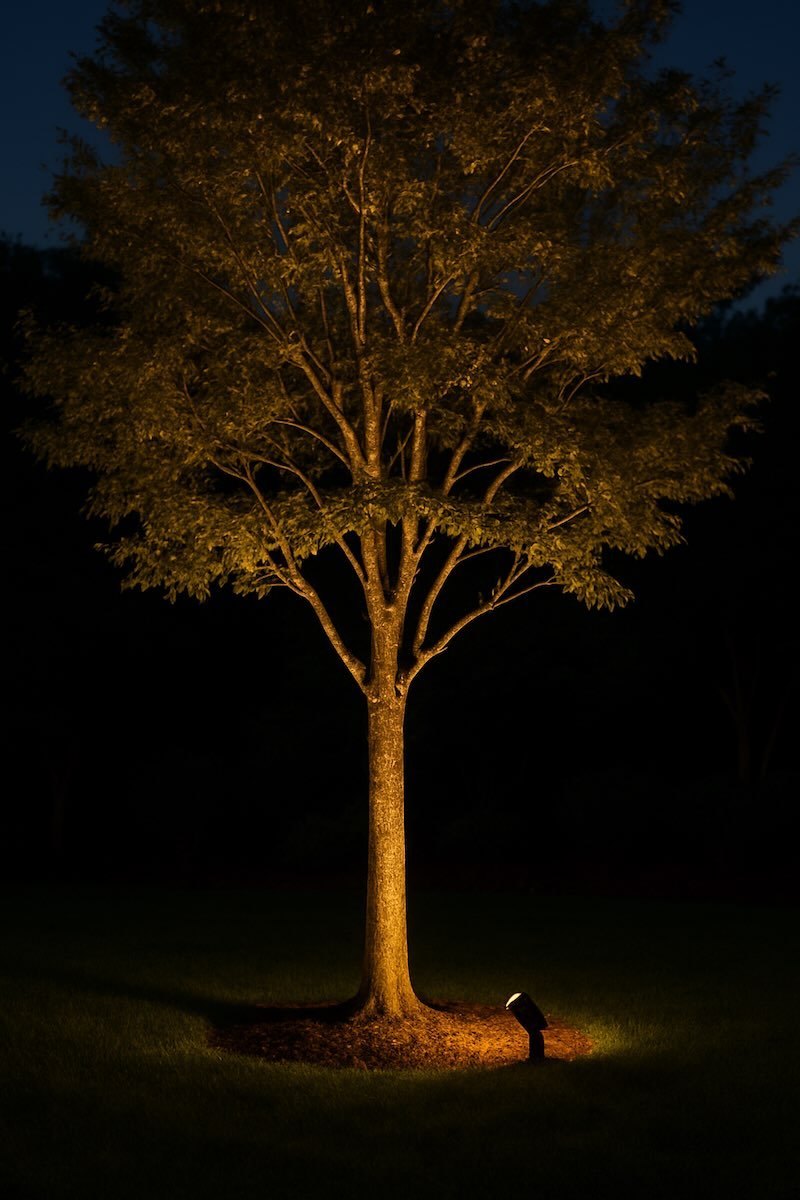What Features Should I Highlight With Landscape Lighting?
Landscape lighting transforms a yard after dark, turning familiar spaces into inviting, dramatic, and safe environments. But one of the biggest questions homeowners face is what to light and how to light it.
The right lighting doesn’t mean illuminating everything. It’s about selecting key features that define your space and using light to draw attention to them. Here’s how to decide what deserves the spotlight.
1. Trees: The Stars of Landscape Lighting
Trees are natural focal points that add structure and beauty to any landscape. Lighting them properly brings your yard to life at night.
How to light them:
Uplighting: Place a fixture at the base of the trunk and angle it upward to highlight the canopy. This works especially well for oaks, maples, or palms.
Moonlighting: Mount a light high in the branches and aim it downward. It creates soft, natural shadows that mimic moonlight on the ground.
Backlighting: Place a light behind the tree to outline its shape and create drama.
Pro Tip: Use narrow beams for tall, narrow trees and wider beams for broad canopies. A mix of warm and cool tones can create depth and realism.
2. Architectural Walls and Facades
Lighting your home’s exterior walls not only enhances curb appeal but also adds dimension and security.
How to light them:
Grazing: Place lights close to textured surfaces like brick or stone to emphasize depth and detail.
Wall washing: Position fixtures farther away to spread a soft, even glow over larger areas.
Column lighting: Use narrow-beam uplights at the base of columns or pillars for striking vertical definition.
Pro Tip: Warm white (2700K) lighting gives stone and brick a welcoming, natural tone. Cooler temperatures (3500K–4000K) suit modern or contemporary homes.
3. Patios and Outdoor Living Areas
Your patio is often the heart of outdoor entertaining, so it deserves a lighting design that balances comfort and function.
How to light them:
Step and deck lights: Recessed fixtures improve safety without glare.
String or bistro lights: Create atmosphere and define seating zones.
Downlights: Mounted on nearby trees or structures, these simulate soft moonlight for an inviting, relaxed vibe.
Under-cap lights: Perfect for retaining walls, seating benches, or fire pits.
Pro Tip: Layer light at different levels. Use ambient lighting for mood, task lighting for cooking or dining, and accent lighting for focal points.
4. Pathways and Driveways
Path lighting combines safety with subtle beauty. It guides movement while tying your overall lighting design together.
How to light them:
Space fixtures 6–8 feet apart for even coverage.
Stagger lights on opposite sides for a natural rhythm.
Avoid placing lights directly at eye level to reduce glare.
Pro Tip: Low-voltage path lights with warm LEDs are energy-efficient and blend seamlessly into landscaping.
5. Water Features
Lighting water adds elegance and motion to your nighttime landscape. The reflection and shimmer create a sense of tranquility.
How to light them:
Underwater lights: Use waterproof fixtures in ponds or fountains for drama.
Uplights: Illuminate nearby plants or rocks to frame the water’s edge.
Spotlights: Highlight cascades or streams to enhance movement.
Pro Tip: Always use fixtures rated for wet environments and angle lights away from viewers to reduce glare off the water’s surface.
6. Garden Beds and Sculptures
Smaller features like flower beds or sculptures help tie your design together and add visual interest.
How to light them:
Use small, focused spotlights to accentuate texture or shape.
Consider color-changing LEDs for seasonal effects.
Combine uplights and path lights for layered depth.
Pro Tip: Keep the focus subtle. The goal is to highlight form, not overpower it.
7. Entryways and Gateways
Your home’s entry is where first impressions happen, so lighting here should feel welcoming and secure.
How to light them:
Wall sconces: Flank doorways with fixtures that complement your architecture.
Recessed downlights: Great for covered porches and overhangs.
Accent lighting: Highlight gates, address signs, or landscape elements that frame the entry path.
Pro Tip: Avoid fixtures that shine directly into visitors’ eyes. Use shielded or downward-facing options for comfort and style.
Conclusion: Light with Purpose
The best landscape lighting design starts with intention. Choose a few standout features—like trees, walls, and patios—and use lighting to draw the eye naturally from one focal point to another.
By layering uplights, downlights, and path lighting, you’ll create a balanced composition that’s both beautiful and practical. The result: a home that’s safe to navigate and breathtaking to see, even after sunset.
Ready to plan your lighting design? Visit your local lighting showroom or speak with a landscape lighting professional to explore fixtures and layout options that suit your home and style.
FAQ
Should I light every tree or feature in my yard?
No. Lighting too many features creates a flat look. Focus on two or three focal points and build around them.
Can I mix different lighting styles?
Yes, layering different techniques—uplighting, downlighting, and path lighting—creates depth and balance.
What type of fixtures last the longest outdoors?
Solid brass or copper low-voltage fixtures offer the best durability and resistance to weather.

